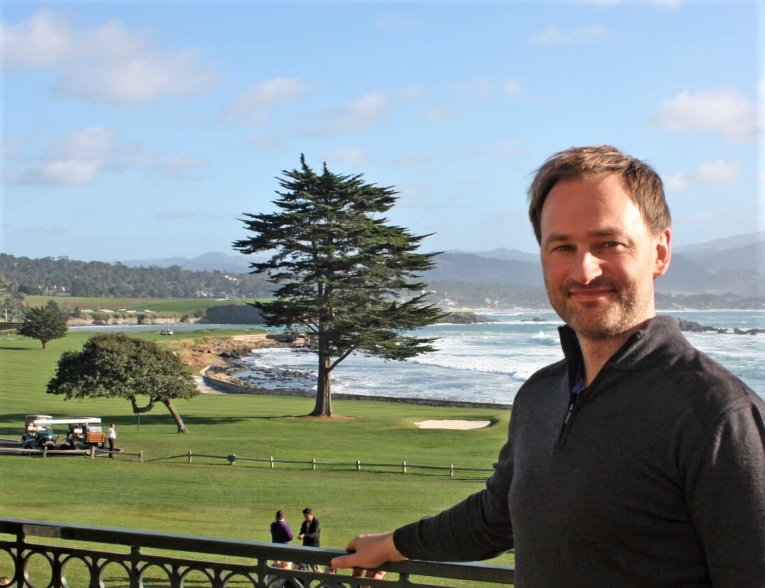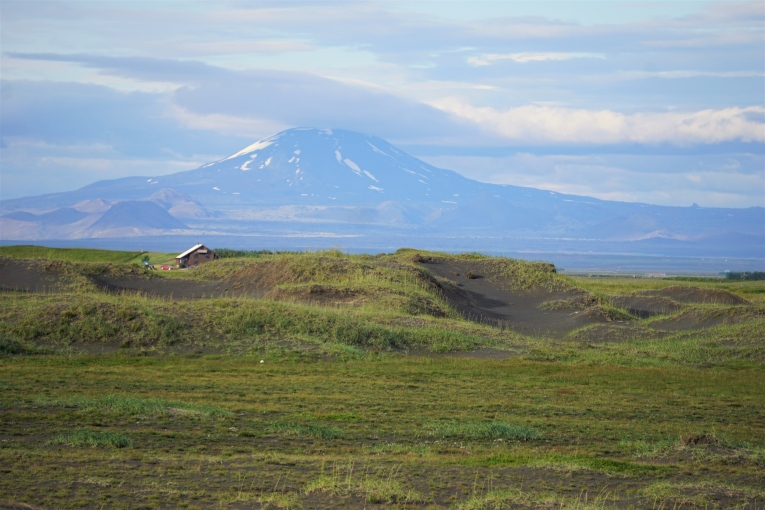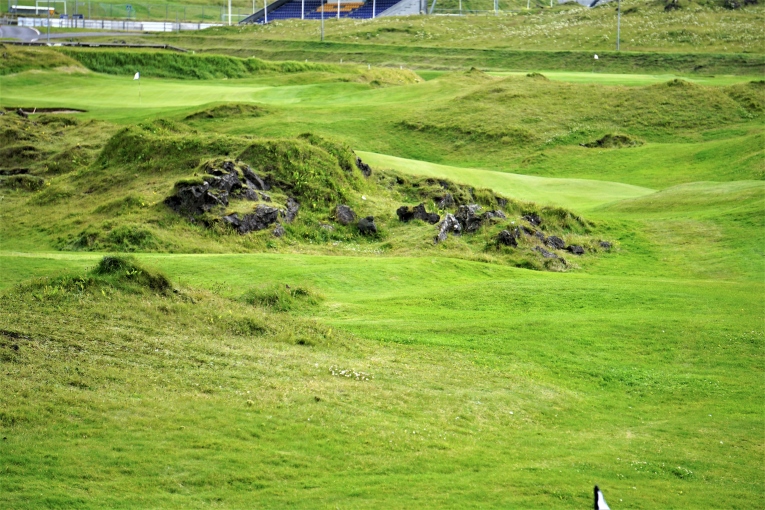Feature Interview with Edwin Roald
November 2018
1. So ……. How does someone born on Iceland development an interest in golf course architecture?
At a young age, I took an interest in building architecture. Then, after seeing Seve play on television, I got into golf. From then on, it seemed obvious that I should combine the two passions.
2. To be clear, you are also an environmental impact expert. How does that dovetail with your design philosophy?
My passion is to use golf specifically as a tool to produce multiple, mutual environmental, social and economic benefits. Some may say: “Yeah, whatever mate. This guy probably has cyanide poisoning from eating all that fermented shark.” I guess this can sound a little bonkers, far-fetched, excessively ambitious or unrealistic, but I think golf has tremendous potential that has yet to be unlocked. There are many ways to apply a synergistic, win-win approach for all, e.g. by mixing land uses and integrating land rehabilitation into the design of golf holes or courses.
For example, I long doubted that I would ever build an island-green, because it is so 1980s. However, on the Sigló project, an island-green par-3 resulted from an attempt to adjust the river current to restore and enhance habitats for sea-run arctic char. This will likely be the project’s best known hole, one which will hopefully help attract golfers. That’s a win-win.
If you combine this with the aim to design courses that can be easily maintained as well as played and enjoyed by golfers of all skill levels, irrespective of social and financial status, then I believe this would be a fair summary of what I want to achieve.
3. Please describe the golf scene in Iceland. In general, I understand that it has more courses per capita than any other country but that’s a bit misleading.
In Iceland, there is a golf course in almost every village. More than ten percent of 340,000 Icelanders play golf on 65 courses. Most of the 45 9-hole courses are lay-of-the-land layouts, in or near almost all small towns or villages, that a few golf pioneers built with their bare hands on borrowed land. Where suitable land was acquired, Iceland’s varied and exotic landscape produces some nice, different type of golf.
Although some are equally and even more dramatic, many of the urban, professional and commercial 18-hole courses are more engineered due to the heavy traffic they get, around thirty thousand rounds in less than half a year.
4. Speaking of which, what is the playing season?
Five months, give or take. In the south, most courses will usually move the pins onto their summer greens in late April or early May, and move them off again sometime in October. In the north, I would say that the season is around thirty days shorter.
This doesn’t sound like much, but I will argue that the Icelandic golf season is among the longest in the world. The long, bright summer nights, where the sun will not even set for weeks on end, allows working people to play all seven days of the week. In most metropolitan areas, this is not realistic. So, if we measure the season in hours, considering working people, then you will have a hard time beating Iceland.
This, along with a few other factors, is why golf is played by all Icelandic demographics. It is a true public game where politicians, fishermen and accountants play golf together into the night. Midnight golf is becoming ever more popular, especially among overseas visitors.
5. Sandy soil would extend the season but does such exist?
Yes, Iceland has an abundance of sand. Almost all of it is black, although in the west, there is some shell sand that resembles traditional bunker sand color. In many ways, drifting sand is Iceland old nemesis, sometimes threatening entire communities. Wind erosion and loss of top-soil is one of Iceland’s largest environmental problems. For example, Iceland’s Soil Conservation Service is the oldest of its kind in the world, preceding the U.S. equivalent that had its hands full during the Dust Bowl years. So yes, there is a lot of sand, but much of it is too unstable.
6. You wrote a paper in 1999 on the ten most influential designs. Please summarize that paper. Would you change any of the 10 courses today? And why?
I listed the courses that I thought, at the time, were golf’s most important or significant course designs in a historical context. In chronological order, they were Old Musselburgh, Old Course at St. Andrews, Royal County Down, Sunningdale Old, Oakmont, National Golf Links of America, Peachtree, Harbour Town, TPC Sawgrass, Sand Hills. That first edition was maybe a little rebellious.
Today, I would replace Peachtree with Augusta, which was the obvious alternative at the time of writing. Peachtree may have been at the forefront in a new and long-lasting trend in golf architecture, but Augusta is without doubt one of the most influential golf courses in history, simply due its exposure. Its influence is both good and bad. I wish Augusta would impact the golfing world more on the basis of routing and concept design, which yielded a strategy based almost entirely on topography, than its intensive turf management and landscaping that have produced unrealistic expectations towards courses with actual budgets.
7. You wrote a treatise entitled ‘Why 18 Holes’ whereby you question the logic of relentlessly building 18 holes on land that is better suited for something less than that. Please give us an example.
At one stage in my 2008 routing work at Brautarholt in Reykjavik, a superior site, I felt that I had discovered seventeen world-class holes, prompting me to ask: ‘Why should I break one of these holes up to create two lesser ones, just to make up the numbers?’ We all do it, but it is dumb to spend more money on a worse product.
This is where all the golf history lessons at Guildford College kicked in. I remembered that for around 450 years, golf was played on courses with hole counts such as 5, 7, 13, 22 and 25. Golf has a history that reaches back six centuries. We have played a standard round, 18 holes, for about a quarter of the game’s history.
We only do because William St. Clair and his fellow R&A gentlemen decided to reduce the number of holes on the Old Course from 22 to 18, “for the improvement of the links” as it says in the 1764 meeting minutes of which the R&A’s Peter Dawson was kind enough to send me a copy. What is the message of these minutes? That “all golf courses shall, from this day forward, aspire to the same rigid number of holes, irrespective of their circumstances”, or maybe that “the number of holes on a golf course shall simply follow the suitable, available terrain”?
With this in mind, I believe that building courses with non-standard hole counts is in line with the true spirit and heritage of the game, and it happens to fit nicely as a response to our changing, more rapid way of life as well as the ever increasing environmental awareness and pressure on land and resource use.
8. I couldn’t agree more! Switching subjects, talk to us about ‘hot’ and ‘cold’ spots.
Okay, nerd alert. I am thinking of this in terms of golf course management, and design, which should of course accommodate good management. Hot spots are those areas on the golf course that get extensive use by the customer, and should therefore be actively and appropriately maintained. Cold spots, however, are those that are rarely used but may be intensively managed nonetheless, for some reason. For example, this would apply to some bunkers or an area of mown rough that very few players find off the tee. By identifying, reducing and/or eliminating such spots throughout the property, one can save considerable man and machine hours, and therefore money, on mowing and other inputs. A part of these can then be directed towards hot spots that may not get enough attention. In business, you want to transfer your resources from cold spots to hot. They are the ones that count, because they are heavily used and scrutinized by the player.
To identify hot and cold spots, I have put together a team that combines aerospace engineering and the industry’s most precise launch monitors to compute thousands of golf shots hit by players of both genders as well as all ages and skill levels, against local topography, temperature, altitude, wind speed and direction and golfer demographics. This simulates years of play, can tell us exactly where balls are likely to go and produces a wealth of very interesting and surprising data. I will never design another course or hole without it, because I know that I can optimize the facility from a management and machine scheduling perspective, to the benefit of my client.
I very much like this fusion of classic golden age architecture and new technology.
9. You are presently consulting in California and building a course in Russia – that is quite a geographic footprint! Based in Reykjavik, how do you find such projects?
You are right and the time zones can be a little demanding. I find that the best way is to try devoting certain days to the west and others to the east. Otherwise, the working day gets too long.
I won Vyrka, my current Russia project, through a design competition in which I believe a dozen firms participated, from both sides of the Atlantic. This is a nine-holer, at least to begin with, on a sandy site surrounded by tall pines near the city of Kaluga, around three hours south of Moscow.
I owe my U.S. work to the environmental credibility that I think I have obtained among non-golf stakeholders. I am typically hired by those seeking to mediate in disputes between golf and non-golf stakeholders, or environmental NGOs that wish to review statements made in golf development proposals. The hard thing is not being able to tell anyone what you are doing, because these can be sensitive cases or situations where I am bound by non-disclosure agreements.
10. You are obviously well traveled. What three designs around the world do you most admire? And why?
Royal Melbourne
In addition to its widely reported, incomparable quality, I admire RMGC for a variety of reasons, anywhere from the firm and fast conditions to the practice of walking the “buggies” across the greens to spare the collars, to bunker presentation and management, to clubhouse design and the buggy divoting pedals. Assuming RMGC’s role as somewhat of a leader among equals in the Sand Belt, I see it as a symbol for the no-nonsense approach to golf that is exercised and expressed so well within that family of golf courses.
Swinley Forest
When I studied in Surrey, England, I was spoiled by the surrounding selection of astonishing heathland courses. This is where our trade evolved into a true craft through the likes of Fowler, Simpson and Colt. Swinley Forest was obviously Colt’s “least bad course,” using his own words, and it is a healthy reminder that par and yardage has little bearing on one’s enjoyment or experience.
Cypress Point
Because the caddie master is half-Icelandic.
11. Tell us about the 12 holes open at Brautarholt. Talk about dramatic!
To be fair, I only did the routing plan, which means that I am mostly responsible for the placement of tees and greens, which inevitably influence the general playing strategy. Excluding some minor exceptions, I was not so much involved in the actual construction and detail design. Having said that, this layout meanders and tumbles over some spectacular terrain flanked by clifftop shores and sandy beaches. The routing focuses on natural green sites and therefore has a somewhat unusual sequence, with the 1st hole being a short par-5, the 2nd a short par-3, before coming to two consecutive short par-4s.
Obviously this is not ideal in terms of flow and pace, but in this case, I felt that the green sites were of such high merit that their use was more important. I also did not want the holes on the peninsula to be very long because I wanted people to have fun in the wind that they have there. The additional three holes are fairly recent. Only two of those are on my routing plan though.
12. Please detail your favorite hole there and what you like so much about it.
Simbi, the reachable par-4 3rd hole, probably comes closest to the way I imagined it at the routing stage. Playing “safe”, away from the sea, produces a more difficult angle for the pitch.

Simbi, the drive-and-pitch 3rd hole at Brautarholt Golf Club in Reykjavik. Hugging the coastline leaves an easier pitch.
13. Is there a timetable to open the last 6 holes or, to the point you raise above, is there even a need to do so?
I don’t know. The question is: If you build six more holes, will your expected increased volume and green fee rates recover the added investment? Not necessarily. Is there perhaps value in the uniqueness around the current hole count? This puts Brautarholt up there with Shiskine and others and I am fine with that.
14. Your Sigló golf course has just opened on the north coast. Is that an example of golf being a piece of a puzzle to help drive tourism?
Yes, among other motives. The whole Sigló story is quite remarkable. This was essentially a golf course relocation project, initially proposed by the local golf club which for forty years had to settle for wet pastures riddled with deep, straight drainage ditches. These ideas, which included the use of an abandoned gravel quarry on the other side of the river, were adopted by Robert Gudfinnsson, a Sigló-born worldwide venture capitalist who was shifting his focus back home, largely to set up shop for his long-awaited Benecta natural food supplement product, made from chitosan.
Robert often told us that he wanted to first improve on the town’s amenities, such as the golf course and the already popular ski slopes, so that qualified professionals would want to make Sigló, or Siglufjördur, their home. So, according to Robert, the golf course was as much about improving quality of life in general.
Tourism remains an obvious element. The setting is very attractive, with the surrounding tall mountains reflected in the tranquil waters where the two rivers meet. The fjord also aligns perfectly for players to enjoy golf at midnight, when the sun will sometimes not even touch the horizon and paint the sky bright red.
Like I mentioned before in the case of the island-green par-3 7th hole, we were able to find ways to integrate previously neglected and timely land rehabilitation, ecosystem restoration and enhancement into the golf course design and construction.
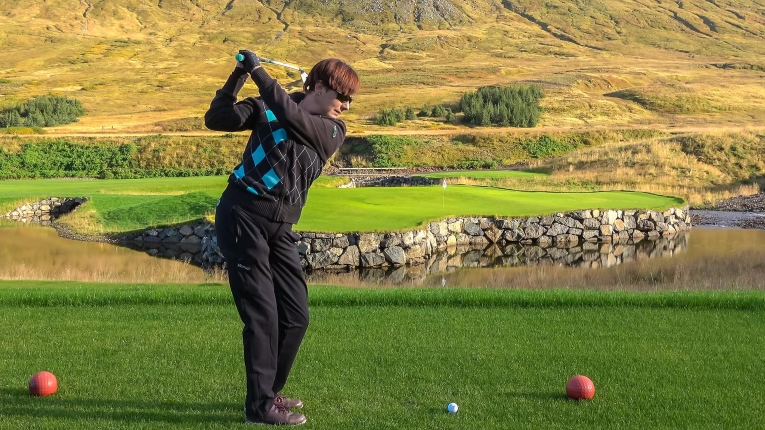
The island-green 7th hole at Sigló Golf, Siglufjordur, Iceland, was a product of river restoration. Photo by Gulli Stebbi.
The new course is also easier to walk than the old. I think we must focus more on walkability, because golf can produce some compelling health benefits. To enjoy them, we need help people play golf on foot until later in life, when our feet will inevitably grow too tired. For those of us who sit in meeting rooms with planning authorities, politicians and other decision makers, we must be able to promote golf’s potential public health benefits if we are to enjoy continued or even improved access to land and other resources. Right now, we are slowly losing this fight.
We also included more non-golf access to the site, such as paths for hiking, running, cycling and horse riding. I think this is important as it produces a classic win-win. We share land, resources and infrastructure, golf becomes more visible, the barriers between “inaugurated” golfers and outsiders are broken down, we get more varied use of buildings, possibly for an extended season, and enjoy added revenue streams.
I would also like to do more to highlight the site’s cultural heritage. The reachable par-4 5th, for example, is played across a natural grazing field from the 1400s. We did not change its topography at all. It has some really nice movement.
There is at least one template hole there also, kind of. The 2nd is a short par-4 played diagonally across the river to a flipped Road Hole green. While I have become a little skeptical of templates of late, I seem to have a soft spot for the Road Hole green. However, at Sigló, I used it as an excuse to tilt the green towards the sun, away from the player. Those things are extremely important in northern climates, to minimize the risk of Anoxia, or turf suffocation under a prolonged ice cover. A sharper solar angle helps provide shelter from cold northerly winds and improve ice melt. This should be a priority. It is pointless to have a nice design if there is no grass on the greens.
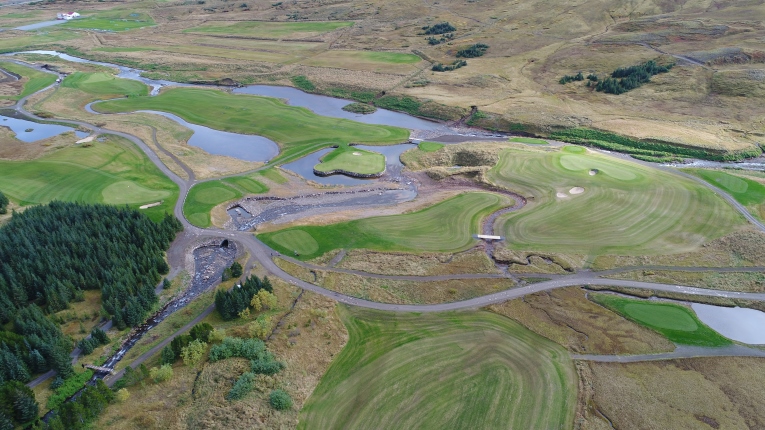
Center of the Sigló property. 1st green middle left, followed by the dual tees on holes 2 and 7. The 2nd hole plays right, across the river, onto a flipped Road Hole green. Top left, the par-5 8th runs the length of the old quarry. The penal appearance is somewhat mitigated by the 80-yard wide playing corridor.
This reminds me of the bunkers. There are only a handful of bunkers out there, of the 19 in total, that are there to help introduce strategy. All the others serve as catch basins for melting ice that cannot filter through the frozen soil. There are no drains on the course. They are unattractive and get clogged by ice, sludge and snow when we need them the most. To reduce maintenance and prevent a wash-out of the face, we have lined a few of them with logs from the adjacent pine plantation, resembling the sleepered bunkers of old.
So, tourism yes, but I am even prouder of the other elements we have included at Sigló, and are still being worked on. The course only opened this year. Inevitably, with such a short construction window, the last few finishing touches still remain, such as on the clubhouse and some of the bunkers. Clubhouse will probably open in summer 2019. Actually, a golf course is never finished. It is a living organism. Like we have heard from the likes of Disney and Pixar. Their films don’t get finished. They are released.
15. Please give an example of how you provided strategic interest to a hole at Sigló without using a bunker.
The Sigló site has a lot of water. In the north, open channels are useful for the same reasons we have talked about before. Every hole at Sigló has either water or sand. However, and unusually, the short par-4 5th only has a winding, narrow stream immediately behind the green. This makes the pitch interesting as it is hard to be aggressive enough.
Strategy on this hole is mostly offered by the angle of the green to the ruins of an old farm that dates back as long as golf in Scotland. This eats into the naturally undulating fairway from the right at the full driving distance for the majority of golfers, narrowing the fairway down to 40 yards from the massive 80 yards before that. By driving into the slot, the green slopes towards you, wide and shallow.
Conversely, if the pin is not far right, one should consider driving short right, choosing a club that can not reach the ruins and accept a blind approach, to enjoy playing along the length of the green.
Driving the green is an option too, but a very risky one with the stream lurking behind.
To be honest, I am torn as to how best to play the hole, which actually makes me think that maybe it will establish itself as the best one on the course, surpassing the two consecutive par-threes ahead that are more visually stunning. That would be nice, because the 5th was the least expensive in construction. Talk about doing less, but delivering more.
16. What are your three favorite courses in Iceland that you didn’t build?
Vestmannaeyjar (Vestmann Islands)
Although the back nine hugs the clifftop coast, I am more fond of the inland front nine. They are routed across some of the most interesting golfing terrain in all of Iceland. Holes 6 to 8 are Iceland’s oldest holes, including the reachable par-4 8th, one of Iceland’s best holes.
Reykjavik GC. Old Course/Grafarholt.
This has a special place in my heart because this is where I got introduced to golf. I was a member at Reykjavik Golf Club for more than a decade before going abroad to learn more about golf and golf architecture. To get in, I had to get letters of recommendation from two members, which goes to show how quickly Icelandic golf has changed from a somewhat elitist game to a popular, public one.
Gláma Golf Club in Thingeyri, West Fjords.
One of Iceland’s smallest and most remote golf clubs. This has some very interesting holes that seem mostly natural, including the par-3 Dam Hole. I worry that this course may be abandoned soon. I hope not.
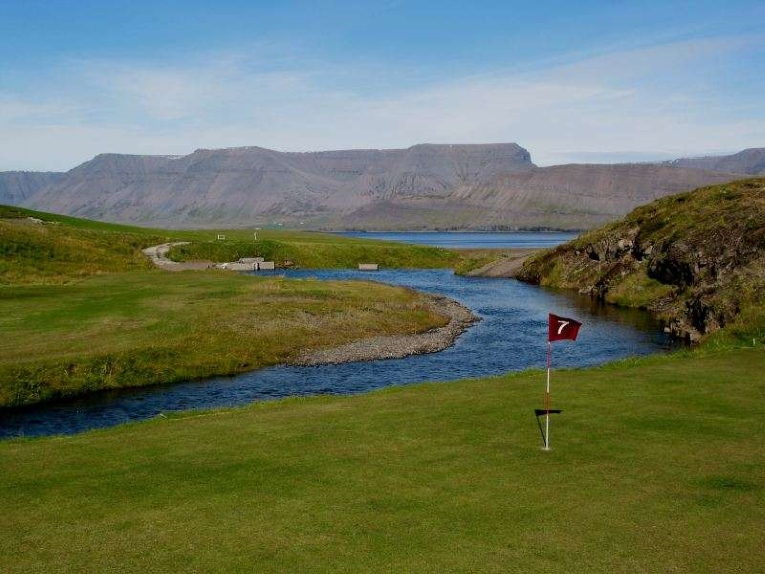
The charming Gláma Golf Club near Thingeyri, West Fjords. A remote course fighting for its existence.
17. Iceland has become the #1 travel spot in the world. Describe the ideal golf trip there with some sight-seeing mixed.
Inevitably, as a native Icelander, I will have a tendency to shy away from the mainstream attractions, such as the Blue Lagoon and the Golden Circle consisting of the Geysir hot springs, Gullfoss waterfall and the ancient Thingvellir parliament site. Still, these are almost mandatory for a first-timer but they will be crowded. I often take my mid-summer guests to these sites late at night when they are quiet.
I think you should take 10 days to do the Ring Road around the whole country, taking day-trips in and around Reykjavik for a couple of days on both ends. In between these, follow the weather and see the sites, from the Snaefells glacier in the west, to Látrabjarg in the West Fjords, along the northern coastline hugging the Arctic Circle, around the East Fjords to the glacial lagoon near Höfn in the southeast.
Play golf in peace and quiet on a pure rural nine-holer when the mood strikes.
18. You very kindly gave Joe Andriole and me a tour of one of the best sites I have ever seen for a golf course. The potential exists for holes to weave through and over dunes, run along an estuary and play across something reminiscent of heathland. To top it off, the backdrop is a volcano! Are you in a position to discuss that project?
Having you and Joe out there was a pleasure and I was glad to hear how much you liked the site, which must unfortunately remain nameless a little longer. The client and I are still working on the preliminaries, but I think it is fair to say that this sand site is perhaps the best that I have dealt with and could give Iceland a world-class golf course. I can hardly think of anything better, professionally, than to contribute to my country in such a way.
19. Good luck with it – the potential is phenomenal. There must be some other intoxicating sites available, yes? Can you see the day when Iceland will have top tier golf?
Yes, I think Iceland will have a world top-100 course by 2030.
20. Why should someone hire Edwin Roald?
1. If you want to enjoy enhanced credibility beyond golf,
2. If you care about the environment, want to contribute to it and get recognized for it,
3. If you want to reach out to your community, e.g. by integrating other land-uses,
4. If you want to maximize golf’s under-promoted health benefits, e.g. by reducing the need and demand for golf carts,
5. If you want to optimize your facility, maximize enjoyment for players of all skill levels and minimize inputs and cost,
6. If you want to accommodate and embrace innovation, stand the test of time and avoid being made irrelevant by the rapid technological advances of tomorrow,
7. If you want to appeal to a new generation, in addition to golf’s current customer base,
8. If you want to cut through, re-think or challenge established norms in terms of the use of predictable golf course features such as sand bunkers, the emphasis on yardage, and even the number of holes,
9. If you want to be unique and set yourself apart,
… then we should talk.


